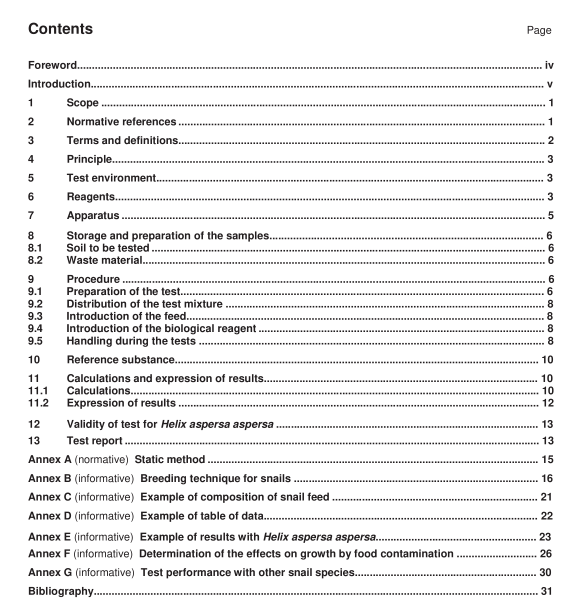BS EN ISO 15952 pdf download

BS EN ISO 15952 pdf download Soil quality — Effects of pollutants on juvenile land snails (Helicidae) — Determination of the effects on growth by soil contamination (ISO 15952:2006)
4Principle
Juvenile land snails (usually Helix aspersa aspersa Miller) are exposed during a period of 28 days to a testmixture containing the test substance, preparation or matrix at different concentrations. The test mixture isfreshly prepared and renewed every 7 days.
According to the objectives, the test mixture may be prepared with artificial soil (6.3.2) or with a suitablenatural soil (6.3.3).
The snails are fed during the test with uncontaminated food.
The effects on growth (fresh mass and shell diameter) and on survival are measured after 28 days ofexposure (optionally, effects could be measured every 7 days during 28 days).
The results obtained during testing are compared with those of a control to determine the NOEC or LOEC andto allow the estimation of the concentration which reduces the growth of the snails by 50 % within 28 days withrespect to the fresh mass [ECso,m (28 days)] and to the shell diameter [ECso,d (28 days)] or other valuesof ECx.
lf the concentrations selecled result in lethal effects,the results obtained during testing are compared withthose of a control and used for estimating the concentration which causes the death of 50 % of the snails[LC5o(28 days)]-
For particular applications,various parameters (ECx,NOEC,LOEC, LCso) can be assessed (optional) afterexposure periods lower than 28 days (7 days,1 4 days or 21 days).
The test is conducted in two stages:
– a preliminary test intended to indicate both the non-observed effect concentration,NOEC,and the
complete growth inhibition. The resulting dose-response relationship is important for the proper design ofthe definitive test;
a definitive test specifying the concentrations which cause between 10 % and 90 % of growth inhibition. ltis not necessary to perform a final test where the preliminary test has not revealed any inhibitory effectsat the maximum concentration tested.
5Test environment
The test shall be carried out at a temperature of (20 ±2) °C under a day-night photoperiod of 18 h to 6 h.Theillumination intensity (artificial light of daylight type),without any natural light in the test containers shall be50 lux to 100 lux.
6 Reagents
6.1Water, of purity at least deionized6.2Biological material
Test organisms shall be juvenile snails. The recommended species is Helix aspersa aspersa Miller whichshall be 3 to 5 weeks old, having a mean fresh mass of (1±0.3) g and a shell diameter of (15,5 ± 1) mm.
NOTE The use of some other genus and/or species of Helicidae is possible (see examples and conditions inAnnex G).
The snails shall be selected from synchronous breeding in order to form a population as homogeneous aspossible with respect to size, mass and age.The breeding techniques for snails are described in Annex B.
After a nursery period (3 to 5 weeks, see Annex B), the young snails shall be used after at least 1 week of aestivation and no more than 5 months. The aestivation is carried out in round wooden boxes (approximately 1 2 cm in diameter by 4 cm in height), with the snails under dry conditions, at a temperature of 1 7 °C to 20 °C. Two to three days before starting the test, snails shall be woken by spraying water (6.1 ) into the boxes used for aestivation. The proportion of snails not woken shall be less than 1 0 %. As soon as they have resumed activity (snails not stuck to the walls of the box and which are beginning to move about), the snails shall be transferred to a box (7.1 ) that has been moistened with water (6.1 ). The bottom of this box either can be covered with absorbent paper that has also been moistened, or can contain some test substrate (6.3) moistened to 50 % to 60 % of its water-holding capacity. Between waking and the start of the test (2 to 3 days), the snails shall be fed (6.4).
6.3 Test substrate 6.3.1 General According to the objectives of the study, either an artificial soil (6.3.2) or a suitable natural soil (6.3.3) is used as test substrate. NOTE Artificial soil may be used as a control and dilution substrate to assess the effect of a substance or of a preparation, or to compare different soils or waste, or to assess the effects of a contaminated soil. Natural soil (field soil) may be used as a control and dilution substrate in order to assess, for example, the effect of the incorporation of wastewater treatment plant sludge into the field soil or to test the effect of a contaminated soil (in this case an uncontaminated soil comparable to the soil sample to be tested ought to be used).









